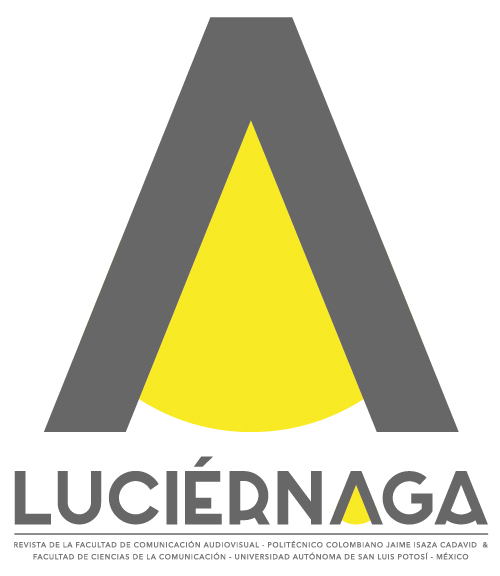

Artículo de Investigación
Post-Colonial Narrative and Language as Aesthetic Matter In Ciro Guerra’s Embrace Of The Serpent
La Narrativa Poscolonial y el Lenguaje como materia estética en El Abrazo De La Serpiente de Ciro Guerra
A narrativa pós-colonial e linguagem como matéria estética Em O Abraço Da Serpente De Ciro Guerra
Luciérnaga: Revista Virtual
Politécnico Colombiano Jaime Isaza Cadavid, Colombia
ISSN-e: 2027-1557
Periodicity: Semestral
vol. 11, no. 21, 2019
Received: 12 November 2018
Accepted: 04 February 2019

Abstract: The text analyzes the characteristics of colonial structures: race, ethnicity and loss of innocence, in the film by the Colombian director Ciro Guerra, Embrace of the Serpent (2015). For this, a dialogue is created with theoretical ideas from Fanon, Quijano, Shohat and Stam. This film is considered a critical postcolonial film.
Keywords: cine, Ciro Guerra, audiovisual, narrative, postcolonialism.
Resumo: O texto analisa as características das estruturas coloniais: raça e etnia, perda de inocência, no filme O Abraço da Cobra (2015) do diretor colombiano Ciro Guerra. Para isso, um diálogo será criado com idéias teóricas de Fanon, Quijano, Shohat e Stam e isso nos permitirá considerar este filme como um filme pós-colonial crítico.
Palavras-chave: cine, Ciro Guerra, audiovisual, narrative, postcolonialism.
Resumen: En el texto se analizan las características de las estructuras coloniales: raza, etnia y pérdida de inocencia, en la película El abrazo de la serpiente (2015) del director colombiano Ciro Guerra. Para esto, se creará un diálogo con ideas teóricas de Fanon, Quijano, Shohat y Stam. Se considera esta película como un film poscolonial crítico.
Palabras clave: cine, Ciro Guerra, audiovisual, narrative, postcolonialism.
Conflict of territory, races, history
In the first scene of Embrace of the Serpent (2015), young Karamakate watches the river as if he had noticed that something that will change his life will arrive: a canoe that carries a sick white man called Theo and Manduca, his loyal and native tribesman traveling companion. Theo, gravely ill, arrived to Karamakate´s territory to ask him to come with him with the objective of looking for the yakruna, a flower that would cure Theo’s illness. From the beginning of the film, Colombian director Ciro Guerra (1981) exposes the main conflict of the film:
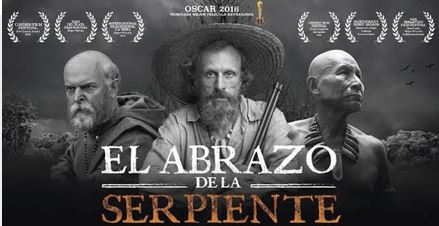
Karamakate only has a kind of aversion for the white race who wiped out his tribe and a hard disapproval for a native who supports that white. This short scene is a good example of what, as spectators, we are to see all along the film: a conflict of territory, races, history, points of view argued by the director in the script and sustained by an ambitious narrative structure.
As García Gil et al. state in their article about Colombian cinema in the first decades of the twentieth century: “Realidad, representación y dimensión axiológica en el cine. Una mirada a la cinematografía colombiana de la primera década del siglo XXI”
“the main film subjects in Colombian cinematography industry were the country's armed and social conflict, kidnapping, forced displacement, drug trafficking, emigration, and other everyday situations such as neighborhood life, family relationships and passion for football.
Those subjects addressed all the fictions and stated models from which traditional cinematographists didn’t escape from and repeated on and on because they were very successful in terms of economic profits. Even more, narco-cultural narrative was exported abroad and we can confirm that by the success of soap operas such as Narcos (2016).
Subjects that explore topics related to the culture of regions of the country such as music and others intimate matters that do not represent violence, are not common in Colombian cinema. However, there is a little movement of directors who are approaching the atypical nuances of society and the Colombian reality are assumed in recent cinema from various genres and aesthetic approaches such as cinema, comedy, thriller, black and indigenous cinema, documentary, animation, literary adaptations as established by García Gil et al. Along with this new kind of exploration, critics consider that the aesthetic imposed by violence can be considered as a plus in order to make of Colombian cinema a reference and a tendency in the world as it speaks about the country’s reality. But, on the other hand it is valuated the technical and the narrative quality of new directors making a sort of balance in the visual, narrative and thematic quality as argued by Osorio.
In that order of ideas, Ciro Guerra surges as a kind of anti-establishment director. He began his career in 2004 with the film La Sombra del Caminante (Wandering Shadows) and then in 2009 directed Los Viajes del Viento (The Wind Journeys). Embrace of the Serpent (2015) puts into dialogue the life of two ethnologists with a fictional discourse of the disappearance of indigenous people in the Colombian Amazon.
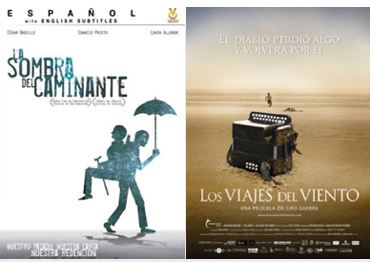
1. Dialogue of Theodor Koch-Grunberg and Richard Evan Schultes
The film is based on two books: the first is the journal Vom Roraima zum Orinoco (1911) by Theodor Koch-Grunberg (1872 – 1924), a German ethnologist and explorer who made a precious contribution to the study of the Indigenous peoples in South America, in particular the indigenous population of Amazon region. In that book there are photographs that revealed the existence of the disappeared tribes.

The other ethnologist is Bostonian Richard Evan Schultes (1915 – 2001). He took pictures also from those communities and put them into a book called The Plants of the Gods: Their Sacred, Healing, and Hallucinogenic Powers (1979).
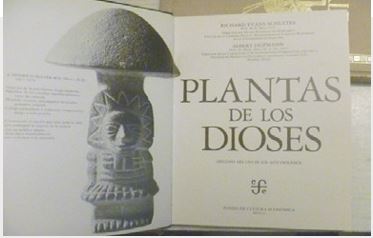
The Amazon that Koch-Grunberg and Schulte met was not, of course, an innocent territory as it was described in several journals of conquers during the colonial Spanish and Portuguese period. Indeed, their achievements as ethnologists (and we can call them scientist as well) are even more remarkable if we consider the fact that, in many areas where they traveled, they found themselves living and working in the shadow of the cluster of atrocities committed for rubber workers since the beginning of the twentieth century.
2. Sovereignty in territories called "savages"
It should be noted that the spirit of the nations towards the end of the nineteenth century was to exercise sovereignty in territories called "savages" and their populations to control planetary natural resources. Thus, in 1895, the English poet Rudyard Kipling (1865-1936) wrote the poem The White Man's Burden, considered as the hymn of imperialism:
Take up the White Man's burdenSend forth the best ye breed -Go bind your sons to exileto serve your captive's need,To wait in heavy harnessOn fluttered folk, and wild -Your new-caught, sullen peoples,Half devil and half child. (1997)
The poem is considered as an apology to the European colonization that disputes the world against the nascent powers of the United States and Japan. Together with Kiplin, the French poet Jules Ferry, evoked the "need to civilize the lower races" as argued by Michel Pierre on his book 1900/1910 Une Presque Belle Époque (23). This is mentioned to contextualize the problematic of the historical time proposed by director of the film.
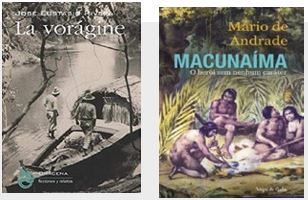
It is important to say that respecting this subject, many literary novels were written, for instance La Vorágine (1924) from Colombian writer José Eustacio Rivera (1888 - 1928), Macunaíma (1928) from Brazilian writer Mario de Andrade (1893 - 1945) and recent publications such as La Casa Verde (1966) and El Sueño del Celta (2010) both from Peruvian writer Mario Vargas Llosa (1936).

This film will inevitably make us think as well about other master’s pieces such as Aguirre, the Wrath of God (1974), Fitzcarraldo (1982) and Cobra Verde (1987) from German director Werner Herzog (1942), all filmed in South America, in terms of the narrative of the jungle but not in terms of the Herzog’s colonial point of view, where colonial structures are established by subordination of others.
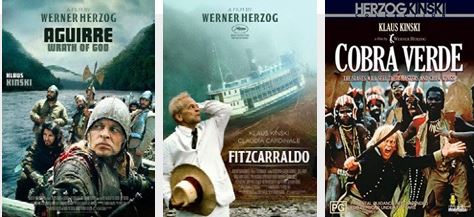
3. El film
Embrace of the Serpent was shot and edited in black and white, which can also give a poetical point of view of the conflict faced by the director. We must consider as well that this film is about a voyage into the deeper and stunning Amazon basin, full of colonial and ethnography blistering ranging issues of disappearance of indigenous cultures. This black and white aesthetics can be interpreted as a way to express the sorrow of the native people that contrasts with the colorful of Amazonian forest. This film develops in a parallel way two stories of white explorers, separated by time into the Colombian Amazon. Both of them have Karamakate as a principal character in two different moments of his life.
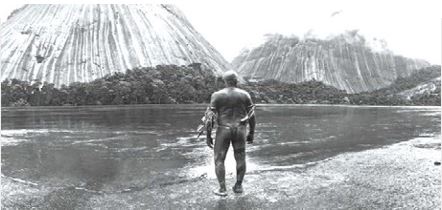
Karamakate always plays the role of a guide in the forest, first as young for German anthropologist and explorer Theo and his disciple Manduca and then, old Karamakate, for Bostonian explorer Evan. Both encounters have the characteristic of a journey in which a guide will conduct the other to a location where a revelation will take place.
Even for the German as for the Bostonian explorer, Karamakate, the indigenous guide through the Amazonian forest is only a way to achieve what they are looking for. For them, Karamakate represents only somebody that will lead them to a final objective, which could be understood as a practice of eurocentrism and colonialism. The canoe bringing Theo and Manduca to the shore of the river where young Karamakate waited and vigilated in a preventive way allows us to think that Theo’s journey has begun in other boundaries. The conviction of Young Karamakate by Theo’s promise of taking him to the hypothetical place where all the members of Cohiuano community have survived from colonial white expansion becomes perhaps the only thing in all the mystical universes that might change his mind. That way Karamakate decide to accept the deal of healing Theo in change of knowing where exactly surviving members live.
We can consider after the encounter of the white man and the indigenous young Karamakate as a representation issue of race and racial binaries. Moreover, we can state that their relationship, in the same order of ideas of Shohat and Stam, plays in borderline of defining their identities (801). This is the beginning of the first journey which, as we watch all along the film, will become a tragic journey: for Theo’s colonial mind, this travel will have the objective of surviving but for Karamakate it becomes a kind of spiritual journey. This journey will have four stops that will feed the story by developing the different relationships between these characters. Because of that, and due to the young Karamakate’s distrust to white people, the director proposes some representative spaces of otherness between them.
First stop
So the first stop of the travelers is in a little tribe where indigenous people were habituated to presence of the white man. There, Theo shows them his compass and speaks that it is used to know the position of the stars which surprises the chief of the tribe. At the moment when they have to go, Theo realizes that his compass has disappeared, he becomes angry and states that this object can’t be in the hands of the indigenous because he thinks that the technology will erode the native know-how of celestial navigation and at that point, young Karamakate spears his arrogance by saying "You cannot forbid them to learn." This leads us to have reflection about who is the owner of knowledge. For European colonizers only their knowledge had a real value fact that made disappear the ancestry knowledge of indigenous people. For Theo, forbidding the use of the compass is a way to avoid the loss of innocence.
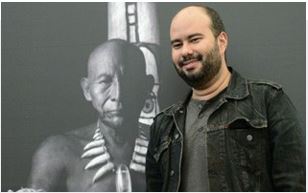
Guerra, as director and writer, reveals a series of historical and critics concerns using the resource of fiction. At this point, we can consider the idea of a fiction as a representation of the historical facts in order to be criticized. Sothat and Stand on their article “Stereotype, Realism, and the Struggle over Representation” argue that
Literature, and by extension cinema, do not so much refer to or call up the world as represent its languages and discourses. Rather than directly reflecting the real, or even refracting the real, artistic discourse constitutes a refraction of a refraction; that is, a mediated version of an already textualized and “discursivized” socioideological world. (803)
The journey of characters is only an excuse for the director to propose us a critical point of view of colonial structures: the vanishing of native tribes and the outrageous actions and crimes perpetrated by white settlers on their territory for the raising of North American and European rubber industry. This industry encouraged a big wave of explorers acting in the name of science and progress to Amazonian basin, a territory still virgin after the independency from Spain and Portugal. These men invaded and destroyed not only the lands where the natives had lived in for centuries, but also, stole their know-how, and colonized their minds. The result of those actions was indigenous people working as slaves for whites in their own territory. By this fact, Guerra states the problem of race and ethnicity.
Speaking about colonial structures and ownership of knowledge, a paradigm of race and colonialism proposed by Peruvian sociologist Anibal Quijano who states in his article written in 2000, “Raza, colonialidad del poder, eurocentrismo y America Latina” that coloniality is based on a racial/ethnic classification of the world's population, where the notion of race legitimizes colonial relations of domination, insofar as it "naturalized the experiences, identities and historical relations of coloniality" (243). For Karamakate, the European and American who enslaved and damaged his tribe are considered as agents of a genocidal conquest and rapacious destruction.
Young Karamakate criticizes also the position of Manduca. He is a native man who was a slave and had to fill a pot of rubber everyday to avoid the amputation of one of its members. Theo bought his freedom and as a proof of gratitude, Manduca decided to be his servant. It’s true that Theo considered him as a disciple but finally, because his colonized mind, Manduca becomes his slave as well. Manduca learned to speak German and even to write the letters to Theo’s family in Germany, he became also his interpreter for indigenous languages and took care of Theo when he was sick.
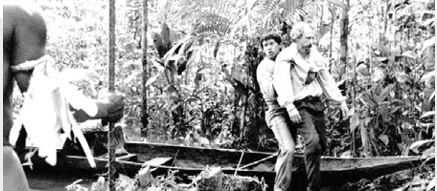
Second stop
There’s a special sequence when three voyagers arrived to an indigenous cemetery between the trees where rubber was collected. At that moment, Manduca loses his mind and begins kicking all the containers spilling out all the collected rubber, which propitiates the concern of an amputated slave. In that moment, the slave asks for his death, and Manduca takes Theo’s shotgun which surprises young Karamakate. He reacts preventing the slave from being killed. Karamakate takes the weapon and spear it. After leaving the slave crying and returning to the canoe, a shot is heard in the air. This particular scene makes us think about the values for the three characters: Theo is carrying a weapon which can be interpreted that he is willing to kill, while young Karamakate is disposed to defend life, and Manduca is in the middle of both: he takes the weapon but doesn’t shoot. According to this, we can conclude that Manduca represents the boundary between the white colonizers and the indigenous colonized. For young Karamakate, Manduca stands for a sort of mimesis of white in the sense of Shohat and Stam: Manduca is one of “them”, he desire to act like them, so
“within hegemonic discourse every subaltern performer/role is seen as synecdochically summing up a vast but putatively homogenous community, and representations of dominant groups, on the other hand, are seen not as allegorical but as “naturally” diverse […]”
This quote makes us think about how colonial structures can permeate native values and how the supremacy of the eurocentrism is the model of establishing relationships of superiority/inferiority between white and native indigenous. We can understand that Manduca is colonized and the models that he follows correspond to those imposed by Theo. Franz Fanon, in his book Black Skin White Masks argues in relation with blacks that “not only must the black man be black; he must be the black in relation to the white man. […] The black man has no ontological resistance in the eyes of the white man” (Fanon 83). In that order of ideas, we can put indigenous people at the same level of black people for analysis talking from the same side to define their otherness. The ideas of Fanon give us lights to understand the colonial relationship imposed by Europeans in the Americas (understood as a hole). Fanon completes: “the black man […] does not know at what moment his inferiority comes into being through the other” (83), which leads us to think that the otherness for indigenous is defined as a relationship of inferiority and superiority for white people.
Third stop
The third stop of the travelers takes them to a catholic mission in the middle of the forest. The three voyagers arrive in the seeking of supplies and they are received by an armed Spanish priest in charge of a group of orphan children of slaves of the rubber wars that were not allowed to speak in their own native language (consider as language of devil) and were obliged to sing and pray, in the words of the priest, they were being saved from “cannibalism and ignorance”. The priest accepts their presences with the condition of not speaking to the children. It’s interesting the course that the story takes at this point because the film’s language changes from Cohiuano language to Spanish to indicate that they are in a colonized territory handled in the name of the catholic church.
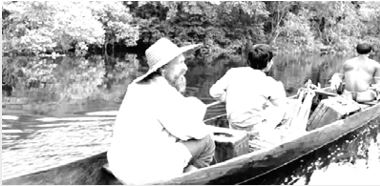
The climax of this step takes place when young Karamakate speaks with the children indicating them to speak in their own language and learn from the forest: “Don’t let our song fade away”. The priest realizes that and once everybody is sleeping, he begins to beat the children, situation that awakens the wrath of Karamakate and Manduca and finishes with the death of the priest, the abandonment of children to their fate and the escape of the three travelers in the middle of the night by the river. This story inside the story will be important for understanding the path that aged Karamakate and the Bostonian explorer will follow twenty years later.
The death of the priest is interpreted in this case as an act of rebellion of the subaltern embodied by the two natives before the hegemonic power of the church that denies the free development of the indigenous communities. Once again, we can bring up that category of loss of innocence mentioned above. The children subjected to this mission, a kind of concentration camp, lack the criteria to judge the type of formation that they received and that was imposed by the priest, that in fact could be interpreted as if a blindfold were placed in their eyes for not to observe beyond and that, in conclusion, is the spirit of colonization. What the priest wanted and, therefore, the church, was to colonize the children’s minds and at this point is when Karamakate comes to “emancipate” them.
Last stop
The last stop of the trip is where, according to Theo, the survival community of Karamakate was located, and considered by the native as disappeared. The place was configurated in an open field devastated and organized according to what could be called “civilization”, there is a military post and many Indigenous who lie drunk on the roads. Karamakate, upon entering there, discovers that his people have evidently disappeared, that is to say that they have succumbed to colonial structures and have reduced their ancient practices, and in other words, they have been colonized and subjugated to structures of Europeanization.
There, under a dead tree, grew yakrunas, the flower Theo was looking for to be healed and which at the same time was the goal of his journey. Karamakate, resentful, seeing the state of the natives and what had happened to their minds, sets fire to the flower, which represents the end of Theo's hope of being healed. The geographical location where this moment takes place is that of the Colombo-Peruvian border, countries that at that moment disputed a warlike confrontation precisely because of the sovereignty over the rubber lands due to uncontrolled extraction that had in some ways become a run-down race undertaken by foreign initiatives.
Final reflection
In 1845, the Argentine writer Domingo Faustino Sarmiento published his work Civilization and Barbarism, canon work of Latin American literature, where an inversion exercise of the terms civilization and barbarism is performed. The first of them refers to the concept of progress brought to America by the Europeans: city life, laws, political organization, regular government, scientific practices, collegial education, everything that characterizes “cult” people; and the second, how Europeans themselves called what they found here: Indians living naked, defending themselves with rudimentary weapons, justice without forms, pagan gods. Sarmiento proposes to call civilization the practices used by the natives before the arrival of the Europeans, and barbarism to the methods used by the Europeans to implant their way of perception of the world. Well, these categories related to Embrace of the Serpent are represented in the borderline: that place where converge, in this case, white and indigenous, Spanish and Cohiuan, civilization and barbarism, jungle and city.
With this last stop, Karamakate understands that the jungle as a sacred place no longer exists, and therefore, he assumes that it is better to continue in his self-exile, isolated in his hut in the middle of the forest. The rubber industry, driven by the superpowers of the United States, France and Germany, led to a return to slavery practices in Latin America, the disappearance of ancestral cultures, the colonization of the minds of the Indians, and the environmental deterioration of the jungle. The jungle becomes a space, as seen for example in La Vorágine, one of the novels cited above, in which everything is hyperbolic and voluptuous, and as director proposes, a vortex alters the chronotope, a sort of
movement but to certain imaginary direction that doesn’t exist anymore and where a map is configured as well as the notion of time appears, both conception of European civilization.
The second history takes place twenty years later after the encounter between young Karamakate, Theo and his disciple. Old Karamakate is found in the jungle by Evan when the native drew his dreams in a stone. Old Karamakate fears that he has arrived to the moment of the lost of his memories, a chullachaqu: an ‘empty, hollow’ as he named in Cohiuano. The Bostonian came into the jungle with the excuse of searching of the yakruna, the flower leitmotif of the journeys and whose drawings were found in book written by Theo during his journey and sent to Germany by Manduca after Theo’s dead. At that moment, Evan without knowing that the man drawing in the stone was young Karamakate proposes him to lead the search of the mentioned flower. Evan offers him a one-dollar note arguing that it’s a lot of money. In the middle of the jungle money has no value fact that represents one of European practices to get information. The motivation of aged Karamakate is to undertake a journey which allows to him to recuperate his memories and exit from this unexpected amnesia. “You are not one – you are two men,” said old Karamakate to Evan as he notices that with him he will retraces Theo’s steps and thinking that Evan is a incarnations of the same soul. Even if the terrain becomes familiar for Karamakate, he decided just to leave Evan lead the expedition arguing that he should follow the path indicated in his dreams.
It’s necessary to mention again that the narrative proposed by the director is to develop both histories in a parallel way with the journey as a thread to link stories. In that sense, director makes use of the images of landscapes, the forest and images of continual water that connect the distant time periods which flow together as a hole.
Evan and old Karamakate where captured and taken to the mission site where they discover the ruins of the place and also the ruins of the structural hierarchy of the catholic mission: an isolated cult with a self-declared messiah and redeemer of the indigenous in charge. At this point of the movie, director proposes a narrative that make us think about a horror movie where Karamakate has to heal a young dying indigenous wife of a self-proclaimed white messiah in order to be released and continue his travel. He healed the woman with a potion and the messiah celebrated her life with a ritual where Karamakate give all the grown orphans he had left years ago when he arrived with Theo and Manduca a kind of drug that make them eat literally their Messiah’s body. Once again, Karamakate acts as a sort of emancipator from religion to those orphans.
Even if this passage of the film makes an apology to horror movies, we can attribute to the hole of images the intention of a denunciation through the fiction, even more, we consider this as a constructed coded nature of artistic discourse hardly precludes all reference to life in terms of Shohat and Stam: “Films which represents marginalized cultures in a realistic mode, even when they do not claim to represent specific historical incidents, still implicitly make factual claims.” (802)
As mentioned before, the new journey undertaken by Karamakate has a redemptive meaning: the need to recover his memory. This new framework defines the metamorphosis of the film: the first story, as demonstrated, acquires a sense of denunciation and demarcation of the relationship of colonial subjects, while the second story, acquires an artistic and narrative nuance as a poetical journey, that turns towards the mythical, in which the symbology of the jungle,
that is to say, its sounds and beasts, together with the music and the mystical experience of the yakruna become the main argument. However, in this case, representation and impersonation (pseudo divine) are confused which allows the relationship between Karamakate and Evan to be redefined as something new for the foreigner in which there is an attempt to apprehend the new environment. Collision in the relationship is inevitable since the relationship of otherness remains marked in terms of colonizer-colonized and this can be seen when Evan attempts to kill the old Karamakate.
The other relevant aesthetic aspect is the one observed at the moment when Evan consumes the yakruna after an initiation ritual with Karamakate in the top of the mountains: he enters in a trance elucidated through abstract images in color. At this point, about two hours after the beginning of the film, color becomes a form of rupture with what Guerra had exposed so far. These images suggest movement, hallucination and psychedelic which are juxtaposed with the aesthetics of the Amazon.
What Ciro Guerra wants to denounce with these two stories is that colonial structures, although arranged from the sixteenth to the twentieth century, left their mark on the contemporaneity of the Latin American republics. Although the film is framed at the beginning of the twentieth century, it seeks to generate a reflection on contemporary colonial practices, the existence of binarisms that define colonial subjects, the lack of independence of citizens and States and, lastly, the destruction of the environment. The narrative proposed by the director values the views of both the colonizing subject and the colonized subject. The film of Guerra, in addition of presenting a considerable aesthetic proposal, also is a discourse that denounces the set of ancient and current practices of colonization. Like Sarmiento's work, Embrace of the Serpent dichotomizes the issue of civilization and barbarism, raising doubts about the definition of both categories, finally, what is civilization? what is barbarism? The viewer can have his own answers. However, like the literary works of Rivera, Llosa and Andrade, the approach of the jungle as labyrinth, inhospitable topos and in which the relationships are woven around the subordination, lead to reflect on the matter of
the limits of the territory which at the same time, are the limits of the human mind, that is, that barbarism, in European terms, is a natural and human matter as it is consider nowadays.
Ciro Guerra emphasizes on the boundaries that has to do with the importance of fixity in the stereotyping of others. As Dyer says on his article “White”, “clear boundaries are characteristic of thing white, and also what keeps whites clearly distinct form blacks. The importance of the process of boundary establishment and maintenance has long been recognized in discussion of stereotyping representation (828). In other words, setting boundaries is functional for dominant groups and becomes a characteristic attribute of colonizers subjects. This is a colonial text whose mise-en-scène characterized the otherness as a fact but not as a whole.
Embrance of the Serpent also opens up the question of the process of how the colonial relationships take place. Both stories are proposed as a guideline to the approach of relations of subordination: who serves who, who gives the orders; in what territory these relationships occur. However, what the director does is not only to raise these issues, but to deconstruct the paradigm of the colonial subject in some way: for the jungle as a natural framework, there is no difference between those who inhabit it and those who explore it.
References
Dyer, Richard. “Stereotype, Realism, and the Struggle over Representation.” Critical Visions in Film Theory. Boston: Bedford/St. Martin’s. 2011. 822–839.
Fanon, Frantz. Black Skin, White Masks. London: Pluto Press. 2008.
García Gil, Mónica Eliana, Ceballos Hurtado Gloria Inés, and Arturo Uscátegui Maldonado. "Realidad, representación y dimensión axiológica en el cine. Una mirada a la cinematografía colombiana de la primera década del siglo XXI." Razón y palabra. 78. 2011. 13-31.
Guerra, Ciro. Embrace of the Serpent. Ciudad Lunar. 2015. Film.
Kipling, Rudyard. White Man's Burden. National Phonograph Company. 1997.
Osorio, Oswaldo. Realidad y Cine Colombiano (1990-2009). Medellín: Universidad de Antioquia. 2010.
Pierre, Michel. 1900/1910 Une Presque Belle Époque. Paris: Gallimard. 1999.
Quijano, Aníbal. “Colonialidad del poder, eurocentrismo y América Latina”. In: Edgardo Lander (ed.) La Colonialidad del Saber: Eurocentrismo y Ciencias Sociales. Perspectivas Latinoamericanas. Buenos Aires: Clacso. 2000. 201- 245.
Sarmiento, Domingo Faustino. Civilization and Barbarism. New York, Hafner. 1960.
Shohat, Ella, and Robert Stam. “Stereotype, Realism, and the Struggle over Representation.” Critical Visions in Film Theory. Boston: Bedford/St. Martin’s. 2011. 800–822. Print.
Tarkovsky, Andrey, and Kitty Hunter-Blair. Sculpting in Time: Reflections on the Cinema. University of Texas Press. 1987.
Notes
Author notes


